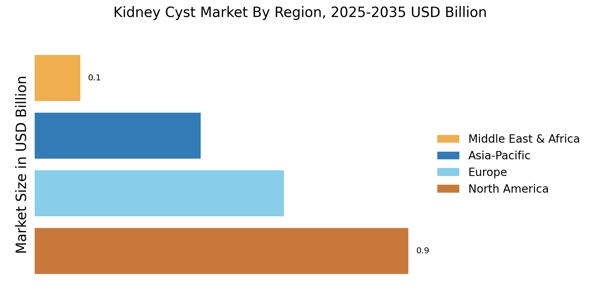Rising Incidence of Kidney Disorders
The increasing prevalence of kidney disorders, including kidney cysts, is a primary driver of the Kidney Cyst Market. According to recent data, the incidence of kidney cysts has been observed to rise, particularly among older populations. This trend is likely attributed to factors such as aging demographics and lifestyle changes. As more individuals are diagnosed with kidney-related issues, the demand for effective diagnostic and treatment options is expected to surge. This growing patient population necessitates advancements in medical technologies and treatment modalities, thereby propelling the Kidney Cyst Market forward. Furthermore, the rising awareness regarding kidney health is likely to contribute to early detection and management of kidney cysts, further stimulating market growth.
Rising Awareness and Education on Kidney Health
The increasing awareness and education surrounding kidney health are pivotal in driving the Kidney Cyst Market. Public health campaigns and educational initiatives are effectively informing individuals about the importance of kidney health and the potential risks associated with kidney cysts. This heightened awareness is likely to lead to earlier diagnosis and treatment, as individuals become more proactive in seeking medical advice. Additionally, healthcare providers are emphasizing the significance of regular check-ups and screenings for kidney health, which may further contribute to the growth of the Kidney Cyst Market. As awareness continues to rise, the demand for diagnostic and therapeutic options for kidney cysts is expected to increase, fostering market expansion.
Technological Innovations in Imaging Techniques
Technological advancements in imaging techniques, such as ultrasound and MRI, are significantly influencing the Kidney Cyst Market. Enhanced imaging modalities allow for more accurate diagnosis and monitoring of kidney cysts, which is crucial for effective treatment planning. The introduction of high-resolution imaging technologies has improved the detection rates of kidney cysts, leading to increased patient awareness and subsequent treatment options. As healthcare providers adopt these innovative imaging techniques, the market is likely to experience growth driven by the need for precise diagnostic tools. Moreover, the integration of artificial intelligence in imaging analysis may further enhance diagnostic accuracy, thereby positively impacting the Kidney Cyst Market.
Growing Demand for Minimally Invasive Procedures
The rising preference for minimally invasive procedures is reshaping the Kidney Cyst Market. Patients increasingly favor treatment options that offer reduced recovery times and lower risks of complications. As a result, healthcare providers are adapting their practices to incorporate minimally invasive techniques for the management of kidney cysts. This shift is likely to drive the development of new technologies and treatment modalities that align with patient preferences. Furthermore, the growing body of clinical evidence supporting the efficacy of minimally invasive procedures may encourage more patients to seek treatment, thereby expanding the market. The Kidney Cyst Market is poised to grow as these innovative approaches gain traction among both patients and healthcare professionals.
Increased Investment in Healthcare Infrastructure
The ongoing investment in healthcare infrastructure is a significant driver of the Kidney Cyst Market. Governments and private entities are allocating substantial resources to enhance healthcare facilities, particularly in regions with a high burden of kidney diseases. This investment is likely to improve access to diagnostic and treatment services for kidney cysts, thereby increasing patient engagement and treatment rates. Enhanced healthcare infrastructure facilitates the availability of advanced medical technologies and skilled professionals, which are essential for effective management of kidney cysts. As healthcare systems evolve, the Kidney Cyst Market is expected to benefit from improved patient outcomes and increased demand for innovative treatment solutions.


















Leave a Comment